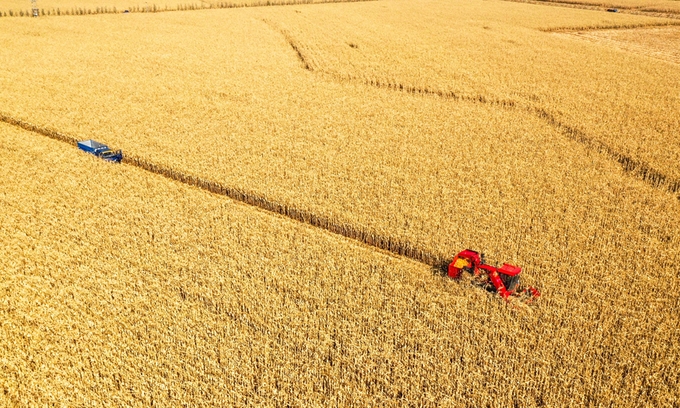May 29, 2025 | 18:41 GMT +7
May 29, 2025 | 18:41 GMT +7
Hotline: 0913.378.918
May 29, 2025 | 18:41 GMT +7
Hotline: 0913.378.918
The pattern of the US as the only major corn supplier for China is changing as the nation tries to diversify its import sources, experts said on Sunday.

Mechanized corn harvesting in progress in Tongliao on October 13, 2022. Photo: Xinhua
The arrival of the 53,000 tons of feed corn on May 4 marked the official start of South African corn shipments to China. The first corn shipment from Brazil arrived at the Mayong Port on January 7.
China adding two corn import sources within months is expect to change the situation in which the nation was highly dependent on corn purchases from the US and Ukraine - two Northern Hemisphere countries.
Increasing imports from Southern Hemisphere countries also means that the pattern of the US as the only major corn supplier for China is changing in 2023, experts said.
On the one hand, Ukraine's corn exports have been tilting toward Europe due to its conflict with Russia. On the other hand, the US has been cracking down on China, leading to continuous tension between the two countries, Li Guoxiang, a research fellow at the Chinese Academy of Social Sciences, told the Global Times.
From the perspective of national food security, especially amid the risk of geopolitical conflicts, it is necessary for China to explore more sources of corn imports, Li said.
In addition to natural disasters, rising geopolitical tensions suggest that China needs to strengthen risk management for grain imports and "not put all of its eggs in one basket," Li added.
According to data from China's General Administration of Customs, the nation imported a total of 7.52 million tons of corn in the first quarter. Of the total, 2.85 million tons were from the US, accounting for 37.8 percent, followed by 2.16 million tons from Brazil (28.8 percent) and 2.09 million tons from Ukraine (27.7 percent).
The US and Ukraine were in "absolute dominant positions" shipping corn to China in the previous two years, supplying more than 90 percent of the country's corn imports. In 2022, 72 percent of China's corn imports came from the US and 26 percent from Ukraine.
It is clear that the share of corn coming from the US fell sharply in the first quarter of this year, experts said.
The shipment of the 2.16 million tons of corn to China accounted for nearly 30 percent of Brazil's corn exports in the first three months. China has surpassed Japan, becoming the largest buyer of Brazilian corn, according to an analysis by ITG Futures Co.
Adding the two suppliers will help form a complementary supply pattern between major corn producing areas in the Northern Hemisphere and those in the Southern Hemisphere. It is conducive to further balancing global seasonal and regional corn supply fluctuations and helping stabilize the global supply chain for China's corn imports, COFCO Corp, the Chinese buyer of the South African corn, said in a statement released on Friday.
(Global Times)

(VAN) Vikas Rambal has quietly built a $5 billion business empire in manufacturing, property and solar, and catapulted onto the Rich List.

(VAN) Available cropland now at less than five percent, according to latest geospatial assessment from FAO and UNOSAT.

(VAN) Alt Carbon has raised $12 million in a seed round as it plans to scale its carbon dioxide removal work in the South Asian nation.

(VAN) Attempts to bring down the price of the Japanese staple have had little effect amid a cost-of-living crisis.

(VAN) Fourth most important food crop in peril as Latin America and Caribbean suffer from slow-onset climate disaster.

(VAN) Shifting market dynamics and the noise around new legislation has propelled Trouw Nutrition’s research around early life nutrition in poultry. Today, it continues to be a key area of research.

(VAN) India is concerned about its food security and the livelihoods of its farmers if more US food imports are allowed.